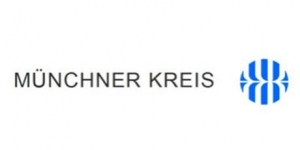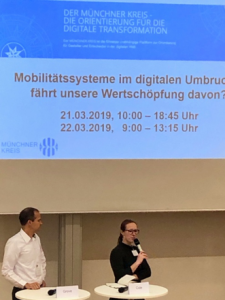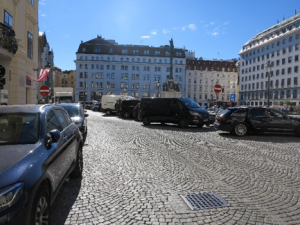This was the question asked by the Münchner Kreis in Potsdam at the two-day symposium „Mobility Systems in the Digital Transition“ at the end of March 2019. In workshops and presentations, experts from science and practice presented and discussed the following questions:
- How is the mobility value chain changing?
- What does service centring mean for the future mobility ecosystem #SMARTMobility and #SMARTCities?
- How is Europe preparing for the #SMARTMobility offensive from China and America?

The Munich Circle is a non-profit registered association, which has been dealing with questions of technology, society, economy and regulation in the field of information and telecommunication technologies as well as media since 1974. He wants to give people in leading positions guidance in the digital transformation.
The current Chairman of the Executive Board is Prof. Dr. Michael Dowling.
I was a participant on behalf of the Bundesverband eMobilität BEM e.V. as their scientific advisory board and representative for Mobility-as-a-Service (MaaS) and China. Representatives of all affected sectors were represented, only the automotive industry shone by absence and was missing as an important technical and power promoter of our future mobility systems.
Diagnose Deutschland: Mobilitätsinfarkt

Mobility is one of the most urgent social challenges of the 21st century and the foundation of our global economy. This makes it a driver of growth and prosperity. The freedom to move ourselves and goods across national borders and continents is an important pillar of our quality of life and livelihoods, which in turn are strongly influenced by changes in our climate. Professor Andreas Herman, Director of the Customer Insights Institute at the University of St. Gallen, even declared mobility to be a human right. On our own doorstep in Germany, we are currently experiencing a mobility infarction: our mobility behaviour on the roads, railways and in the air is exceeding capacity limits, is very expensive and marked by the loss of time due to traffic jams, air pollution and extremely high land consumption in the cities.
Figure 1: Dr. Mara Cole, Director Connected Mobility at Zentrum Digitalisierung Bayern and Dr. Nico Grove, CEO Institut für Infrastructure Economics & Management, summarize the results of the workshops.
Wem gehört der Lebensraum Stadt?
On average, 50% of urban public spaces in European metropolises are dedicated to cars, in Los Angeles the figure is 70%. The cityscape is characterised by streets and car parks and this automatically leads to more traffic. Our infrastructure has grown with the increasing volume of traffic – instead of building human cities, car-friendly cities have been built since the 1950s. The consequences range from polluted air to congestion columns in almost all large and small cities. Last year, air pollution caused by diesel exhaust gases was higher than permitted in 57 German cities. Initial measures have led to compliance with the EU limit value for harmful nitrogen dioxide (NO2) in eight cities. (Source)
Does it have to be like this? The answer is no when Oliver Bertram, architect, urban planner and founder of Wideshot Design GmbH in Vienna, presents his vision of the future. He radically focuses on people and their needs. He demands a higher quality of life, more open spaces, more green space, areas for temporary use, safe streets and residential quarters. Today, vehicles in Vienna are in motion for about 1 hour and spend 23 hours in parking areas. In the future, with #SmartMobility and #SMARTCity solutions, this relationship can be reversed. So 1 hour standstill and 23 hours the vehicle should be in motion. According to his estimation, 60-80% of all parking spaces become obsolete and grey parking spaces could turn into green meeting zones:
 .
. 
Figure 2: Parking area in Vienna Figure 3: Simulation (http://www.wideshot.at/)
According to the calculations of the German Federal Ministry of Economics, 50% of our value added in Germany is directly and indirectly dependent on the automobile. This could change radically in the coming years: Platforms from the USA, batteries from Asia and „Robotaxis“ will redefine the value chain of the mobility of people and goods using low-cost standard hardware.
There’s a lot at stake. If the digital platform for autonomous driving with artificial intelligence for the automobile of the future were to come from the USA and the battery from Asia, Germany and Europe would have lost more than 50 percent of the value added in this area. The associated effects went far beyond the automotive industry. This problem therefore affects not only the companies in the sector, but all economic and government players equally.
Mobility-as-a-Service based on a traffic management system
All this leads to a transformation of today’s motorised private transport (MIV) and to an optimised Mobility-as-a-Service (MaaS) system. The experts agreed that a comprehensive „traffic management system“ (VMS) was needed as a foundation. This controls all traffic according to demand and integrates all other means of transport. An integrated VMS enables mobility services on the one hand and considers our data protection in Europe as a very specific challenge on the other.
Prof. Florian Matthes, Head of the Chair for Software Engineering of Operational Information Systems at the Technical University of Munich, conducted a study in the Munich region in 2018 and showed that the various modes of transport and sectors have little or no willingness to use a common platform. The trend is towards many different individual solutions, with each provider optimizing its own goals for itself.
It remains to be seen whether the customer will accept this. For my part, I don’t want to use more than two dozen different platforms/app services, as I currently do, but a provider who is planning my trip from Munich to Berlin, for example. This platform should (m)suggest an ideal combination of public transport, bicycles, scooters and vehicles. Individually based on my mobility behaviour and my mobility data from the past.
#SmartMobility needs this integrated traffic management for this. According to the Treaty of Rome, the EU has a duty to design this new #SMARTMobility in such a way that on the one hand competition remains, on the other hand mobility in the EU is realized barrier-free and European data protection regulations are observed. Thus, uniform EU licensing conditions and communication standards for VMS and autonomous driving will be required – from #SmartData as a basis and control option with regard to planning but also flexible utilization to real-time coordination between different means of transport. Although these new technologies, mobility as a service and also autonomous mobility, are „ante portas“, no activity of this kind has become known at European level, according to the lawyer Dr. Lang, partner at the law firm Bird&Bird. His proposal: The traffic management system is part of the infrastructure and thus becomes a public task. Private and public companies, including start-ups, can acquire licenses under conditions to be determined and gain access to the VMS by providing the traffic data in anonymous form. Blockchain technology could serve as a basis here in the future. The billing between mobility platforms and means of transport, the coordination and the exchange of data will thus be made possible securely and anonymously. (Source)
#SmartMobility offensive from America and China
Is it possible to find an overall European solution? Will there be a solution in Germany or only individual solutions from providers and municipalities? Does our policy oversleep the trend and leave the field to the technology giants and market leaders from America and China? Questions to which we must now find an answer.
Europe can learn from China and America. Both countries are far ahead of us in mobility issues and the first #SmartMobility solutions have already been successfully implemented. Both countries couldn’t be more different in their approaches
The approach in the USA is:
Business models are developed based on the user and his needs. These are integrated into an overall system without a clearly understood effect – according to purely market economy guidelines.
The Chinese approach is:
A solution is developed by the government for the entire country according to central planning and is then made as usable as possible for the travellers – quasi planned economy specifications.
#SmartMobility made in Europe?!
Claudia Plattner from Deutsche Bahn and Michael Hanke from Detecon AG (Munich) dealt with this topic. Europe could unite the best of both systems. An implementation plan that has been consistently thought through after clear formulation of objectives and whose solution elements have already been developed with and for the travellers. Europe can and should find its own way here, taking into account our social values and principles, such as the protection of privacy. Another way of dealing with data protection is the optional and transparent provision of personal data against added value, such as the planning and implementation of individual mobility needs.
The race for the supremacy of #SMARTMobility solutions, which will be strongly characterized by autonomous, secure, sustainable and intelligent mobility, has begun. We should adopt a credo from the USA and China: „Done is better than perfect“. The expertise, networks and think tanks (including Fraunhofer, Max Plank, Aurora, BEM e.V., Münchner Kreis) are available in Germany. The country that invented the automobile and the railways should now actively drive the mobility revolution forward and assume a leading role again.

